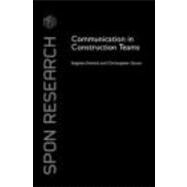
Note: Supplemental materials are not guaranteed with Rental or Used book purchases.
Purchase Benefits
Looking to rent a book? Rent Communication in Construction Teams [ISBN: 9780415366199] for the semester, quarter, and short term or search our site for other textbooks by Emmitt; Stephen. Renting a textbook can save you up to 90% from the cost of buying.
| Preface | x | ||||
|
1 | (12) | |||
|
3 | (2) | |||
|
5 | (3) | |||
|
8 | (1) | |||
|
9 | (3) | |||
|
12 | (1) | |||
|
13 | (23) | |||
|
17 | (2) | |||
|
19 | (2) | |||
|
21 | (6) | |||
|
27 | (1) | |||
|
28 | (3) | |||
|
31 | (5) | |||
|
36 | (18) | |||
|
37 | (6) | |||
|
43 | (4) | |||
|
47 | (7) | |||
|
54 | (32) | |||
|
56 | (2) | |||
|
58 | (13) | |||
|
71 | (12) | |||
|
83 | (1) | |||
|
84 | (2) | |||
|
86 | (36) | |||
|
87 | (1) | |||
|
88 | (7) | |||
|
95 | (5) | |||
|
100 | (3) | |||
|
103 | (12) | |||
|
115 | (2) | |||
|
117 | (1) | |||
|
118 | (1) | |||
|
119 | (3) | |||
|
122 | (40) | |||
|
122 | (6) | |||
|
128 | (3) | |||
|
131 | (4) | |||
|
135 | (4) | |||
|
139 | (3) | |||
|
142 | (4) | |||
|
146 | (3) | |||
|
149 | (3) | |||
|
152 | (4) | |||
|
156 | (3) | |||
|
159 | (3) | |||
|
162 | (19) | |||
|
162 | (9) | |||
|
171 | (7) | |||
|
178 | (2) | |||
|
180 | (1) | |||
|
181 | (43) | |||
|
181 | (1) | |||
|
182 | (2) | |||
|
184 | (3) | |||
|
187 | (25) | |||
|
212 | (1) | |||
|
213 | (9) | |||
|
222 | (2) | |||
|
224 | (16) | |||
|
224 | (7) | |||
|
231 | (3) | |||
|
234 | (1) | |||
|
235 | (5) | |||
| 10 Conclusions and recommendations | 240 | (13) | |||
|
241 | (2) | |||
|
243 | (2) | |||
|
245 | (1) | |||
|
246 | (3) | |||
|
249 | (2) | |||
|
251 | (1) | |||
|
252 | (1) | |||
| Appendix 1 Definition of communication acts attributed to Bales' IPA categories | 253 | (10) | |||
| Appendix 2 Observer reliability: Test results | 263 | (5) | |||
| Appendix 3 Data collection sheet | 268 | (3) | |||
| Appendix 4 Number of meetings observed | 271 | (1) | |||
| Appendix 5 Communication models developed from this research | 272 | (3) | |||
| Bibliography | 275 | (20) | |||
| Index | 295 |
The New copy of this book will include any supplemental materials advertised. Please check the title of the book to determine if it should include any access cards, study guides, lab manuals, CDs, etc.
The Used, Rental and eBook copies of this book are not guaranteed to include any supplemental materials. Typically, only the book itself is included. This is true even if the title states it includes any access cards, study guides, lab manuals, CDs, etc.